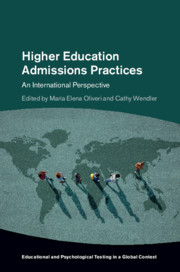Book contents
- Higher Education Admissions Practices
- Educational and Psychological Testing in a Global Context
- Higher Education Admissions Practices
- Copyright page
- Contents
- Figures
- Tables
- Contributors
- Series Editor’s Foreword
- Foreword
- Acknowledgments
- Part I Global Challenges and Common Admissions Models
- Part II Country-Specific Admissions Practices
- Part III Assessments Used in Higher Education Admissions
- Chapter 14 General Academic and Subject-Based Examinations Used in Undergraduate Higher Education Admissions
- Chapter 15 Language Proficiency Assessments in Higher Education Admissions
- Chapter 16 Measuring Student Character: Modernizing Predictors of Academic Success
- Part IV Rethinking Higher Education Admissions
- Index
- References
Chapter 16 - Measuring Student Character: Modernizing Predictors of Academic Success
from Part III - Assessments Used in Higher Education Admissions
Published online by Cambridge University Press: 09 January 2020
- Higher Education Admissions Practices
- Educational and Psychological Testing in a Global Context
- Higher Education Admissions Practices
- Copyright page
- Contents
- Figures
- Tables
- Contributors
- Series Editor’s Foreword
- Foreword
- Acknowledgments
- Part I Global Challenges and Common Admissions Models
- Part II Country-Specific Admissions Practices
- Part III Assessments Used in Higher Education Admissions
- Chapter 14 General Academic and Subject-Based Examinations Used in Undergraduate Higher Education Admissions
- Chapter 15 Language Proficiency Assessments in Higher Education Admissions
- Chapter 16 Measuring Student Character: Modernizing Predictors of Academic Success
- Part IV Rethinking Higher Education Admissions
- Index
- References
Summary
This chapter describes noncognitive assessments that measure skills and traits such as leadership, moral character, empathy, social consciousness, and civic responsibility that may be used in admissions decisions. The traditional measures of noncognitive factors, such as letters of recommendation, as well as more modern tools such as situational judgment tests and biodata, are described, and existing research, possible sources of bias, and concerns related to their use reviewed. Recommendations for using practice for the various assessments are discussed.
Keywords
- Type
- Chapter
- Information
- Higher Education Admissions PracticesAn International Perspective, pp. 276 - 302Publisher: Cambridge University PressPrint publication year: 2020
References
- 6
- Cited by



